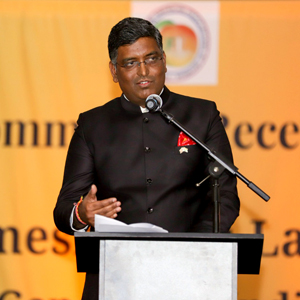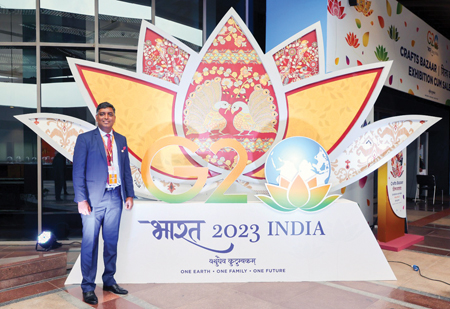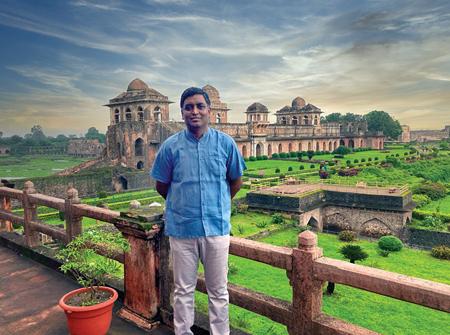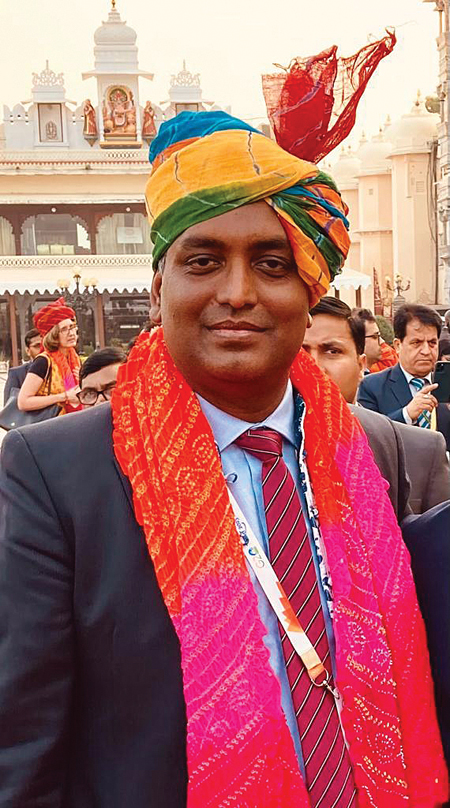Interview: Consul General Shri Ramesh Babu Lakshmanan

The fourth CG of India in Atlanta, who took over from Dr. Swati Vijay Kulkarni in the fall, shares his thoughts on his goals, promoting trade between his jurisdiction and India, business opportunities, and more.
Ramesh Babu Lakshmanan comes with impressive experience in external affairs, having served in various positions at Indian Missions in nations such as Tajikistan, Russia, France, and Sri Lanka. Most recently, he was the operational expert for the G20 Summit held in India before heading the Rapid Response Division and the Control Room for “Operation Ganga” that worked to evacuate Indian citizens stranded in Ukraine after the 2022 Russian invasion.
The following are excerpts from our interview with him. The transcript of a verbal interview has been edited for print consumption.
What are your main goals for your term in Atlanta?
Like all other CGs, the main objective is servicing the Indian community and promoting India. We are interested in further strengthening the partnership between India and the U.S.A., and in exploring and nurturing associations that will help us do that. It may be hard to appreciate the extent of growth in India unless you witness it personally. Reading newspaper articles while sitting here is not the same as going and meeting the actual stakeholders to understand what modern India has to offer. So, we would like to take more delegations from here to India, and vice versa. The other objectives are to have regular interactions with government organizations, business decision-makers, and cultural and professional associations on ideas and areas for further deepening of cooperation. And to continue to improve the processes for Indian visas, OCIs, and other consular services.
 Which sectors in particular do you see as most promising for trade between the Southeastern U.S. and India?
Which sectors in particular do you see as most promising for trade between the Southeastern U.S. and India?
Automobiles, aviation, textiles/carpets, and chemicals have been traditionally strong. India is one of the largest agriculture-based countries and so, there is a lot of potential for partnerships in this sector. India has become a hub for auto parts manufacturing. We are looking to promote spare parts and other automotive-related manufacturing. The medical technology industry is another transformative sector because of the increased healthcare spending in India. It has one of the biggest insurance coverage programs in the world. Hospitality is another booming sector. Healthcare and hospitality, together, hold a lot of promise because India has become a leading destination for medical tourism. The government’s initiatives such as “Heal in India” (medical tourism) and “Heal by India” (serving as the telemedicine provider) are great initiatives. India offers one of the lowest costs of healthcare without sacrificing quality of care and treatment. Pharmaceuticals is another associated healthcare sector with a huge scope. The IT service industry is marching towards a pinnacle, especially with the new technological advancement in artificial intelligence, blockchain, and quantum computing. There is a lot of scope for cooperation in the education sector. New and emerging technologies and the semiconductors industry after the supply chain discontinuity are new areas of cooperation.
How can your office assist small businesses in the U.S. to avail of the large, growing markets in India?
We are here to help them every step of the way—from helping with long-term visa processing to connecting them with various chambers of business in India. We are always working towards bringing and sending business delegations to promote trade between the countries. We are already in touch with the Georgia Economic Development Division. But having said that, not many people come directly to us to discuss these avenues. We are ready to facilitate, we are ready to do matchmaking. I’m also reaching out to the Indian business community here. We need to identify the areas that will resonate here in Southeast through analysis and discussions with various stakeholders. Many new initiatives such as the National Single Window System (NSWS), a digital platform to help identify and apply for approvals according to your business requirements, are making the process more streamlined.
Why do you think India could be a great destination for businesses in the U.S.?
India is growing at a rate of seven percent. According to the S&P, India’s GDP is forecasted to rise from $3.5 trillion in 2022 to $7.3 trillion by 2030. S&P Global has projected that India would become the third-largest economy in the world by 2030. India offers a conducive atmosphere for policy stability and is one of the biggest markets in the world. Not only is it a huge market in sheer numbers, but the quality of these numbers is also important. India has a rapidly growing and ambitious middle class—a great market for consumer and retail products. India will continue to have a youthful population in the coming years. A lot of urbanization is happening. It is a country with one of the highest numbers of digital, cashless payments. For most middle-class Indians, their mobile phone is their wallet. So, whether I want to purchase a ten-rupee banana or jewelry worth lakhs, I use my mobile to make payments. The country has prioritized infrastructure development, which is transforming the landscape. Many unicorn startups have flourished in India. So, anybody who has some ideas will get the talent pool in India to see it through.
Japanese cars became the standard of high quality several decades back. In the last decade or two, Korean cars have also acquired a similar reputation and have gained a massive global market share. With the recent emphasis on manufacturing in India, do you believe Indian cars will be able to compete internationally any time soon?
India is the world’s third largest automobile market. It is the largest tractor manufacturer in the world, the second largest bus manufacturer, and the third largest heavy truck manufacturer. Domestically, India’s focus is mostly on the price-conscious buyer. That is where Suzuki, Maruti, and Mahindra are pitching. In the space of two- and three-wheelers, companies like Bajaj and TVS have captured the market overseas in many places such as Africa, Southeast Asia, etc. The country is now also competing in the global market for high-end cars and coming up with luxury models and SUVs. Not many may know that Jaguar, the British luxury car brand, is now owned by TATA Motors.
 Ford, GM, and Harley Davidson—three big American companies—pulled out from India in recent years. How does that impact India’s quest of attracting MNCs to manufacture in India?
Ford, GM, and Harley Davidson—three big American companies—pulled out from India in recent years. How does that impact India’s quest of attracting MNCs to manufacture in India?
I actually don’t know much about why these companies pulled out; but like I said, this is a very price-sensitive market. I understand Ford had a partnership with Mahindra which did not work out, compounded by, I think, the onset of the pandemic which tanked the market. But, other automotive companies have invested heavily in India. Honda and Suzuki have done very well with two-wheelers and compact cars.
[Top] Ramesh Babu at the Mandu Fort in Madhya Pradesh.
From becoming the fifth largest economy in the world to taking on leadership roles in the world such as the presidency of the G20, India is on the rise! What, if anything, can rain on its parade? In other words, domestically and internationally, what are the risks that India needs to be watchful about?
The predictions are good as of now. I don’t see anything which is going to be a big challenge in stopping the growth of India. We have a strong global presence and great relationships with major international partners as well. I don’t think anything other than unforeseen issues, like another pandemic, could affect it.
Regarding consular services and visa applications, not everyone is well-versed with following detailed online instructions. For many applicants who are not computer savvy, being able to talk to a live person to get clarifications regarding the process would mean so much. If India is the back office for the world, why can’t the Ministry create a back office staffed with workers in India to answer questions for applicants?
 That’s a very interesting thought. It’s not a very complex application compared to other countries where you must fill in pages and pages and keep on continuing to get any verification. It’s a basic document to establish that you have some Indian lineage. People have asked about the application to be made available in their native language. With modern technology, it is possible through Google translation. Uploading the document is what some may find cumbersome. To address all these things, we have a Chatbot with a dedicated officer to respond to it. So, your point of having a back office with a call center where people can ask all sorts of questions is very valid. I will pass on the idea. We will also do some online workshops for volunteers who can help the elderly who are not well-versed with computers. We have been doing such training during consular camps, but we can do it more regularly. We have also recommended a few other changes. It’s an evolving process. For emergencies, this consulate has even opened late at night and on weekends. And then there is the e-visa, which is a very easy and user-friendly application, and you get the visa within 24 hours. Of course, we can always strive for a more human touch.
That’s a very interesting thought. It’s not a very complex application compared to other countries where you must fill in pages and pages and keep on continuing to get any verification. It’s a basic document to establish that you have some Indian lineage. People have asked about the application to be made available in their native language. With modern technology, it is possible through Google translation. Uploading the document is what some may find cumbersome. To address all these things, we have a Chatbot with a dedicated officer to respond to it. So, your point of having a back office with a call center where people can ask all sorts of questions is very valid. I will pass on the idea. We will also do some online workshops for volunteers who can help the elderly who are not well-versed with computers. We have been doing such training during consular camps, but we can do it more regularly. We have also recommended a few other changes. It’s an evolving process. For emergencies, this consulate has even opened late at night and on weekends. And then there is the e-visa, which is a very easy and user-friendly application, and you get the visa within 24 hours. Of course, we can always strive for a more human touch.
Can you tell us about your interests and hobbies?
I love to meet people and listen to them because that’s the biggest way to learn. I can’t get the experience of your many years of journalism but by sitting with you and talking to you for one hour, I have learned so much. I’m very open, and my office is open to anybody. I did play some tennis but since I had a knee injury, I have stopped playing it. I play some basketball and badminton with my kids. I love to watch a lot of sports and am also a movie buff. I like to explore new places and foods. I read a lot to keep up with what’s happening. And I love to spend time with my family. These are my small, small interests.
How does a diplomat deal with his personal conscience during those times when it is in conflict with the official government positions that he is charged to support and promote? Or is that a luxury that needs to be surrendered in order to perform your job effectively?
So, this is a very tricky one. We take this job because we believe in and have faith in India’s positions. Most of the time, there is not much personal conflict. It’s a collective decision which is taken based on the national interest.
Parthiv N. Parekh is the editor-in-chief of Khabar magazine.
Enjoyed reading Khabar magazine? Subscribe to Khabar and get a full digital copy of this Indian-American community magazine.
blog comments powered by Disqus












